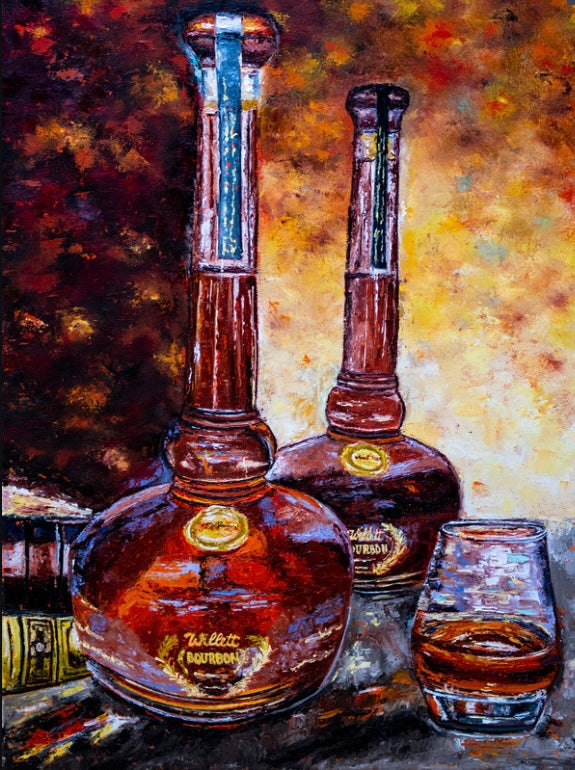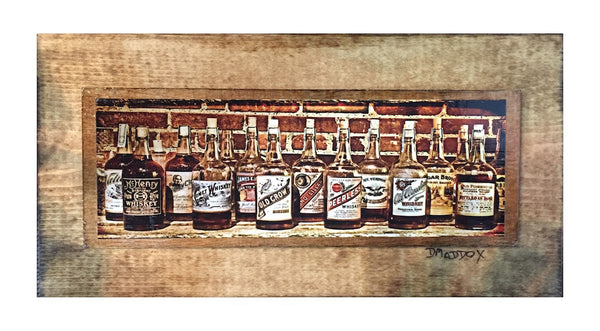Realism Art in the Whiskey Sector: Depicting Moments of Purification
Realism Art in the Whiskey Sector: Depicting Moments of Purification
Blog Article
Recording the Essence of Bourbon Art Via Distinct Visual Representations and Designs
The art of scotch prolongs past the fluid itself, manifesting via a variety of visual depictions that envelop its storied heritage and workmanship. What remains to be uncovered is exactly how these progressing designs show not just the bourbon itself but also the altering landscape of creative interpretation. Bourbon Art.
The History of Whiskey Art

As bourbon manufacturing spread, so too did the wish to elevate its experience with art. From the detailed engravings on early barrels to the fancy tags of modern containers, each element mirrors an unique creative vision, offering as a visual narrative of the whiskey's heritage.
In the 19th and 18th centuries, the surge of the industrial transformation better enhanced whiskey art, resulting in ingenious product packaging and advertising that captured customer focus. Musicians and designers began explore visual appeals, imbuing whiskey-related imagery with symbolic definitions that communicated concepts of tradition, community, and workmanship.
Today, bourbon art remains to advance, mixing traditional methods with modern art types. Realism Art. This recurring discussion in between the spirit and its graph emphasizes the long-lasting bond in between bourbon and society, enhancing the general experience for lovers worldwide
Iconic Bottle Designs
While many factors add to the allure of scotch, famous bottle designs play a pivotal duty fit customer assumption and improving the general experience. The visual discussion of whiskey containers is not just an aesthetic consideration; it offers as a bridge in between the item and the customer, evoking feelings and establishing assumptions.
Distinct shapes, materials, and closures can boost a bourbon brand name's identity, making it immediately well-known on congested racks. For example, the traditional Glenfiddich bottle, with its sophisticated tapered shape, shares a feeling of practice and workmanship, while the bold, modern-day design of the Balvenie container shows innovation and refinement. The usage of colored glass or special appearances can suggest the quality and personality of the bourbon within.
Renowned styles often integrate elements of social heritage, signifying the brand's history and link to its origins. Brand Names like Jack Daniel's utilize a simple, durable layout that resonates with its American whiskey heritage. Ultimately, the impact of bottle layout expands beyond simple functionality; it envelops the significance of the brand name, welcoming customers to delight and explore in the rich tapestry of scotch society.
Label Artwork and Branding
Bottle designs frequently set the stage for what consumers can expect, but label art work and branding play a just as considerable duty in connecting a bourbon's identity. The tag offers as the initial factor of call in between the customer and the product, encapsulating the essence of the whiskey within its aesthetic components.
Efficient label artwork incorporates shade, images, and typography to produce a story that resonates with the brand name's heritage and target market. For example, a label featuring complex illustrations and classic typefaces might evoke a sense of practice and craftsmanship, appealing to lovers. In contrast, vibrant colors and modern design aspects might bring in a younger group seeking technology and enjoyment.


Photography and Visual Storytelling
Capturing the significance of bourbon through photography and visual narration is an art kind that raises the brand name this content experience. This tool transcends mere product representation, delving into the intricate narratives that surround each bottle. By utilizing engaging imagery, digital photographers can stimulate feelings that reverberate with customers, ultimately forging a deeper connection to the scotch brand.
Visual storytelling in whiskey photography often utilizes rich structures, lighting, and composition to highlight the distinct qualities of the spirit. The interplay of light and shadow can highlight the amber tones of whiskey, while the selection of history components-- such as rustic barrels or classy glass wares-- can enhance the brand name's heritage or way of life organizations.
Additionally, catching the ritualistic aspects of bourbon intake, from the putting to the sampling, invites viewers right into a sensory experience, permitting them to visualize the tastes and scents that await. Each photograph not just showcases the item however also narrates of workmanship, custom, and the moments that bourbon can improve - Realism Art. Thus, digital photography ends up being a powerful device in verbalizing the identity of whiskey brand names, positioning them within the broader social landscape
Emerging Fads in Scotch Art
The development of bourbon art is increasingly shaped by modern patterns that show wider societal shifts and customer preferences. This change not only highlights the value of sustainability yet also improves the story surrounding bourbon production.
In addition, digital art has risen in popularity, enabling for ingenious representations of scotch. Artists are leveraging innovation to craft immersive experiences, such as increased fact setups that involve visitors and provide a deeper understanding of whiskey's cultural value. This fad also includes social media sites systems, where aesthetically striking content garners interest and promotes neighborhood amongst enthusiasts.
Furthermore, collaborations between whiskey brands and artists are ending up being more prevalent. These collaborations try this produce limited-edition product packaging styles and special artworks that commemorate both the craftsmanship of whiskey and the creativity of artists. As whiskey art proceeds to evolve, these emerging fads will undoubtedly shape its future, fostering a vibrant junction of society, sustainability, and technology within the scotch neighborhood.
Conclusion
Finally, the art of whiskey encompasses a varied range of visual representations that mirror its abundant heritage and workmanship. From renowned bottle styles and elaborate label art work to engaging photography, each element adds to a wider story that improves the customer's experience. As emerging trends, such as digital art and sustainability, continue to shape this imaginative landscape, the complex about his identification of bourbon remains an enduring resource of cultural link and expedition.

In final thought, the art of scotch encompasses a diverse selection of aesthetic representations that reflect its rich heritage and craftsmanship.
Report this page